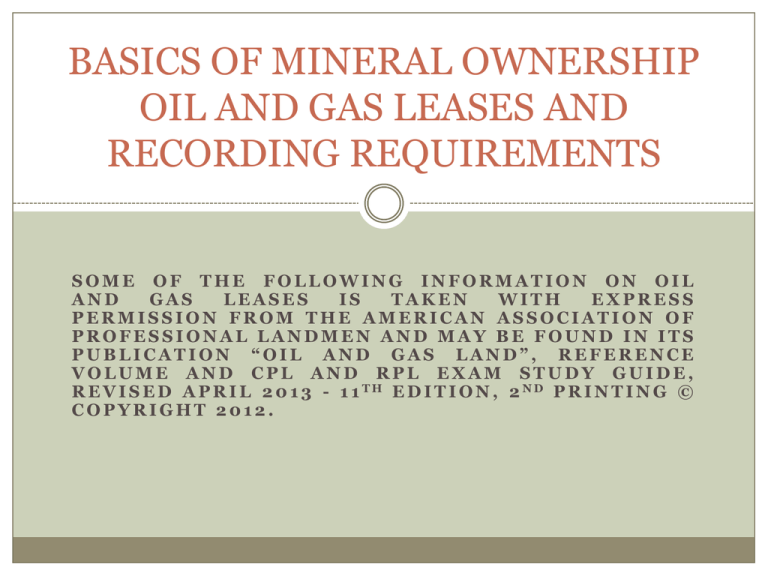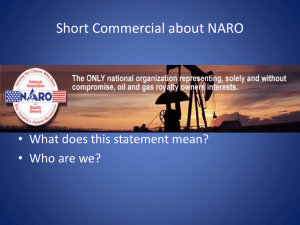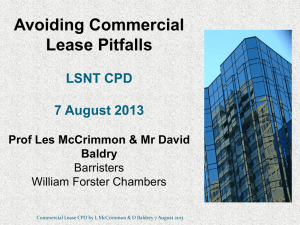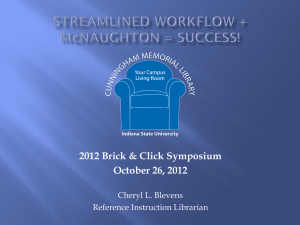Oil and Gas Land - Association of Indiana Counties
advertisement

BASICS OF MINERAL OWNERSHIP OIL AND GAS LEASES AND RECORDING REQUIREMENTS SOME OF THE FOLLOWING INFORMATION ON OIL AND GAS LEASES IS TAKEN WITH EXPRESS PERMISSION FROM THE AMERICAN ASSOCIATION OF PROFESSIONAL LANDMEN AND MAY BE FOUND IN ITS PUBLICATION “OIL AND GAS LAND”, REFERENCE VOLUME AND CPL AND RPL EXAM STUDY GUIDE, R E V I S E D A P R I L 2 0 1 3 - 1 1 TH E D I T I O N , 2 ND P R I N T I N G © COPYRIGHT 2012. The Illinois Basin covers approximat ely 60,000 square miles in Illinois, Indiana and Kentucky. Who Do We Lease MINERAL OWNER - THE OWNER OF THE FEE SIMPLE ALSO OWNS A 100% MINERAL INTEREST. A CONVEYANCE OF THAT INTEREST SEVERS THE MINERALS FROM THE OTHER RIGHTS (SURFACE). LEASES ARE TAKEN FROM THE MINERAL INTEREST OWNER. IF THAT INTEREST IS LESS THAN 100%, THAT PERSON OWNS A FRACTIONAL MINERAL INTEREST OR AN UNDIVIDED MINERAL INTEREST. Insert funny story WHAT IS AN OIL AND GAS LEASE? IT IS: 1 ) A CONVEYANCE, 2 ) A CONTRACT, AND 3) A BUSINESS TRANSACTION. Conveyance It is a conveyance because the mineral owner (lessor) conveys a right to an oil company to explore for and produce oil and gas. Contract IT IS A CONTRACT BECAUSE THE OIL COMPANY (LESSEE) ACCEPTS THE RIGHT TO EXPLORE AND PRODUCE BURDENED BY CERTAIN EXPRESS AND IMPLIED PROMISES. BECAUSE IT IS A CONTRACT, INVOLVING AN INTEREST IN LAND, IT MUST SATISFY THE STATUTE OF FRAUDS. IN OTHER WORDS, IT MUST BE IN WRITING. (ALSO K WHOSE TERM MAY EXCEED 1 YEAR). STANDARD LEASE THERE IS NO SUCH THING AS A “STANDARD” OIL AND GAS LEASE. EVERY LEASE IS DIFFERENT BUT MOST CONTAIN BASICALLY THE SAME PROVISIONS. PROVISIONS HAVE DEVELOPED AS SPECIAL NEEDS AND PROBLEMS AROSE AND FROM DECISIONS OF THE COURTS. THE COURTS GENERALLY ADHERE TO THE “FOUR CORNERS RULE”, MEANING THEY WILL LOOK AT THE ENTIRE LEASE FOR THE CORRECT MEANING THEY APPLY TO A PARTICULAR CLAUSE OR PROBLEM. COURTS GENERALLY CONSTRUE THE LEASE IN FAVOR OF THE LESSOR AND AGAINST THE LESSEE. (EXAMPLE LEASE PROVIDED IN YOUR MATERIALS) WHO ARE THE PARTIES TO AN OIL AND GAS LEASE? MINERAL OWNER(S) = LESSOR(S) OIL AND GAS COMPANY = LESSEE Why is an Oil and Gas Lease Recorded? Effect of not recording Although a deed conveying real estate does not need to be recorded in Indiana to be valid, if unrecorded, it will only be valid between the parties to the conveyance or persons having notice. Indiana Code, states that: A conveyance of any real estate in fee simple or for life, a conveyance of any future estate, or a lease for more than three (3) years after the making of the lease is not valid and effectual against any person other than: (1) the grantor; (2) the grantor's heirs and devisees; and (3) persons having notice of the conveyance or lease; unless the conveyance or lease is made by a deed recorded within the time and in the manner provided in this chapter. See I.C. 32-21-3-3. Indiana Code provides that a lease covering real estate for period in excess of three (3) years should be filed of record within forty-five (45) days of execution and, in the event, the same is not recorded within said time frame it is void as to a subsequent purchaser or lessee for consideration. I.C. §§ 32-31-2-1 and 32-31-2-2. [Regardless of Notice]? WHAT INFORMATION IS NECESSARY TO RECORD LEASE (Indiana Recording Statutes) Name of parties (lessor/lessee) There must be two identifiable parties to a lease for it to be effective. Description of land under lease – A third party must be able to locate the lands described by reading the description referenced in the lease. Date of Instrument (or effective date) – The date of an oil and gas lease sets commencement of the primary term, time for commencement of operations for drilling, and the timing for payment of delay rentals. [Is dating lease a statutory requirement? – delivery/acceptance - date of first acknowledgment] Signature(s) of Lessor(s) - legibly printed, typewritten, or stamped immediately beneath the person’s signature or the signature itself is printed, typewritten or stamped. I.C. 36-2-11-16 Acknowledged by the [Lessor]; or proved by Judge, notary public, etc. I.C. 32-21-2-3 Affirmation Statement (SSN) I.C. 36-2-11-15 Preparer of Instrument I.C. 36-2-11-15 Memo of Oil and Gas Lease SOMETIMES PARTIES TO AN OIL AND GAS LEASE DO NOT WANT SPECIFIC TERMS OF THE LEASE MADE PUBLIC. MOST COMMONLY, THE ROYALTY OR OTHER NEGOTIATED TERMS. I.C. 36-2-11-20 Sec. 20. (a) A memorandum of a lease may be recorded in lieu of the lease itself if the memorandum is executed and acknowledged by the lessor and the lessee and contains: (1) the names of the lessor and the lessee; (2) the term of the lease; * (3) any option of the lessee to renew or extend the term of the lease; and (4) the specific legal description of the leased premises, or a survey or plot plan authorized under subsection (c) showing the location of the leased premises. (b) A memorandum recorded under this section may also contain any other agreement made between the lessor and the lessee in the lease. *Term of Lease The term defines the period during which a lease will be effective – the primary term. It is also called the “habendum clause”, which is derived from the Latin words habendum et tenedum, meaning “ to have and to hold”. Of particular importance in the habendum clause is the “and as long thereafter as oil or gas and associated products are produced” wording, which permits the term to continue as long as production is maintained. This is referred to as the secondary term. WHY IS THIS THE TERM OF THE LEASE IMPORTANT TO A RECORDER? 1. Remember the term of the lease needs to be included in the Memorandum. I.C. 36-2-11-20 Also Important: 2. 3. Affidavit of Cancellation Dormant Mineral Act AFFIDAVIT AND REQUEST FOR CANCELLATION OF OIL AND GAS LEASE IC 32-23-8-1 Void leases Sec. 1. (a) Leases for oil and gas that are recorded in Indiana are void: (1) after a period of one (1) year has elapsed since: (A) the last payment of rentals on the oil and gas lease as stipulated in the lease or contract [NOT IF PAID UP LEASE]; or (B) operation for oil or gas has ceased, both by the nonproduction of oil or gas and the nondevelopment of the lease [SECONDARY TERM]; and (2) upon the written request of the owner of the land, accompanied by the affidavit of the owner stating that: (A) no rentals have been paid to or received by the owner or any person, bank, or corporation in the owner's behalf for a period of one (1) year after they have become due; and (B) the leases and contracts have not been operated for the production of oil or gas for one (1) year. IF THE LEASE IS STILL IN ITS PRIMARY TERM – THIS STATUTE IS NOT APPLICABLE. Certification of void lease IC 32-23-8-2 Formerly cited as IN ST 32-5-8-1 Sec. 2. (a) The recorder of the county in which real estate described in section 1 of this chapter is situated shall certify upon the face of the record of the oil and gas lease that: (1) the leases and contracts are invalid and void by reason of nonpayment of rentals; and (2) the oil and gas lease is canceled of record. (b) The request and affidavit shall be recorded in the miscellaneous records of the recorder's office. Voiding of cancellation IC 32-23-8-3 Formerly cited as IN ST 32-5-8-1 Sec. 3. If, at any time after the cancellation of a lease and contract and within the term provided in the lease or contract, the lessee submits to the recorder: (1) a receipt or a canceled check, or an affidavit, showing that the rental has been paid; or (2) an affidavit that: (A) the lease has been operated within a period of one (1) year before the cancellation, as stipulated in the lease or contract; and (B) the affidavit of the lessor provided under this chapter is false or fraudulent; the cancellation is void, and the recorder shall so certify at the place where the cancellation of the lease and contract has been entered. DORMANT MINERAL ACT DORMANT MINERAL ACT Indiana does not have a statute directly setting forth a procedure for obtaining an oil and gas lease from a mineral owner who cannot be located such as the Severed Mineral Interest Act of Illinois. Instead, Indiana has a statutorily created mechanism for “dormant” mineral interests to lapse and automatically revert to the estate from which they were carved (typically, however, this does not necessarily mean the surface estate). The original DMA was codified at I.C. 32-5-11-1, et seq., and had an effective date of September 2, 1971. The DMA was subsequently re-codified and is now found at I.C. 32-23-10-1, et seq. The purposes of the DMA “are [1] to remedy uncertainties in titles and [2] to facilitate the exploitation of energy sources and other valuable mineral resources.” Section 1 AS USED IN THIS CHAPTER, “MINERAL INTEREST” MEANS THE INTEREST THAT IS CREATED BY AN INSTRUMENT THAT TRANSFERS, BY: (1) GRANT; (2) ASSIGNMENT; (3) RESERVATION; OR (4) OTHERWISE; AN INTEREST OF ANY KIND IN COAL, OIL AND GAS, AND OTHER MINERALS. Section 2 of the DMA provides that a Section 2 Section 2 of the DMA, provides, as follows: “[a]n interest in coal, oil and gas, and other minerals, if unused for a period of twenty (20) years, is extinguished and the ownership reverts to the owner of the interest out of which the interest in coal, oil and gas, and other minerals was carved. However, if a Statement of Claim is filed in accordance with this chapter, the reversion does not occur.” lapsed mineral interest reverts to the owner out of which the interest in the severed mineral was “carved.” It does not state that a lapsed mineral interest automatically reverts to the owner of the surface. By way of example, assume that A controls fee simple title to a tract of land and subsequently conveys the coal, oil, gas and other minerals to B; then B conveys the coal to C, reserving the oil and gas and other minerals. If C’s interest lapses under the DMA for C’s failure to use his mineral interest or for failing to file a Statement of Claim, C’s interest would lapse to the owner of the interest out of which his/her interest in the coal was carved; i.e., B. WHAT IS CONSIDERED A USE? Section 3 of the DMA provides that: (a) A mineral interest is considered to be used when: (1) minerals are produced under the mineral interest; (2) operations are conducted on the mineral interest for injection, withdrawal, storage, or disposal of water, gas, or other fluid substances; (3) rentals or royalties are paid by the owner of the mineral interest for the purpose of delaying or enjoying the use or exercise of the rights; (4) a use described in subdivisions 1 through 3 is carried out on a tract with which the mineral interest may be unitized or pooled for production purposes; (5) in the case of coal or other solid minerals, there is production from a common vein or seam by the owners of the mineral interest; or (6) taxes are paid on the mineral interest by the owner of the mineral interest. The case law interpreting Section 3 of the DMA has construed Section 3 narrowly, and supports the conclusion that the uses described in Section 3 are not illustrative of types of activity that can constitute a use, but are indeed the only types of activity that constitute a use for purposes of preserving the mineral interest. See McCoy v. Richards, 581 F.Supp. 143 (S.D. Ind. 1983) (conveyance of grantor’s coal was not a sufficient “use” under the DMA so as to preserve his interest in all other minerals reserved); Kirby v. Ashland Oil, Inc., 463 N.E.2d 1127, 1129 (Ind. Ct. App. 1984) (“the mere act of leasing one’s mineral interests is not a sufficient use to prevent a lapse”); but see Miller v. Weber, 839 N.E.2d 204, 208 (Ind. Ct. App. 2005) (lessee’s payment of royalties to lessor of mineral rights constituted a use under the DMA preserving the lessee’s interest); Plymouth Fertilizer Co., Inc. v. Balmer, 488 N.E.2d 1129, 1134 (Ind. Ct. App. 1986) (payment of shut-in rentals by lessee was a sufficient use of the interest to prevent an extinguishment of the lease). The payment of property taxes by the mineral interest owner constitutes sufficient use under the DMA. See Consolidation Coal Co. v. Mutchman, 565 N.E.2d 1074, 1080 (Ind. Ct. App. 1990); but see Miller, 839 N.E.2d at 211 (lessor’s payment of capital gains taxes due from receipt of advance royalties was not considered a sufficient use). Section 4 STATEMENT OF CLAIM If there is a sufficient “use” within the statutory period, as provided in Section 3 of the DMA, it is not necessary to file a Statement of Claim. However, given the uncertainties with application of the statute it is recommended. The Statement of Claim must be filed in the “Dormant Mineral Interest Record Book.” (See Section 7) Section 4 of the DMA provides that: (a) [t]he Statement of Claim under section 2 of this chapter must: (1) be filed by the owner of the mineral interest before the end of the twenty (20) year period set forth in section 2 of this chapter; and (2) contain: (A) the name and address of the owner of the mineral interest; and (B) a description of the land on or under which the mineral interest is located. (b) A Statement of Claim described in subsection (a) must be filed in the office of the recorder of deeds in the county in which the land is located. (c) Upon the filing of a Statement of Claim within the time provided in this section, the mineral interest is considered to be in use on the date the Statement of Claim is filed. The former version of the DMA provided a two-year grace period for filing a Statement of Claim for those mineral interests that were un-used for the 20 years that preceded the effective date of the DMA, i.e., September 2, 1971. E X A M PL E : I F M I N E R A L I N TE R E S T W A S C R E A T ED O N SE P T E M B E R 2 , 1 9 5 1 A N D T H E I R W A S N O U SE D U R IN G TH E 2 0 Y E A R P E R I O D TH A T P R E C E D ED TH E E F F E CT I V E D A T E O F T H E D M A , TH E O W N E R O F TH E M IN E R A L I N T E RE ST HAD UNTIL SEPTEMBER 2, 1973 TO FILE A STATEMENT OF CLAIM. If there is a sufficient “use” within the statutory period, as provided in Section 3 of the DMA, it is not necessary to file a Statement of Claim. However, given the uncertainties with application of the statute it is recommended. IF THERE HAS NOT BEEN A STATUTORY USE AND A STATEMENT OF CLAIM HAS NOT BEEN FILED THE LAPSE IS AUTOMATIC!!! Except for the protection afforded in Section 5, there is no requirement that a person who succeeds to the lapsed mineral interest provide notice of the lapse (Section 6). Section 6 Succession of Ownership NOTICE OF LAPSE RECORDER ALERT!!! Sec. 6. (a) A person who succeeds to the ownership of a mineral interest may, upon the lapse of the mineral interest, give notice of the lapse of the mineral interest by: (1) publishing notice in a newspaper of general circulation in the county in which the mineral interest is located; and (2) if the address of the mineral interest owner is shown of record or can be determined upon reasonable inquiry, by mailing, not more than ten (10) days after publication, a copy of the notice to the owner of the mineral interest. (b) The notice required under subsection (a) must state: (1) the name of the owner of the mineral interest, as shown of record; (2) a description of the land; and (3) the name of the person giving the notice. (c) If a copy of the notice required under subsection (a) and an affidavit of service of the notice are promptly filed in the office of the recorder in the county where the land is located, the record is prima facie evidence in a legal proceeding that notice was given. It provides that: Failure to file a Statement of Claim within the time provided in section 4 of this chapter does not cause a mineral interest to be extinguished if the owner of the mineral interest: Section 5 FAILURE TO FILE Section 5 of the DMA is intended to provide an additional layer of protection for holders of several mineral interests in a county and one or more interests failed to be otherwise preserved due to inadvertent oversight. (1) was, at the time of the expiration of the period specified in section 4 of this chapter, the owner of ten (10) or more mineral interests in the county in which the mineral interest is located; (2) made a diligent effort to preserve all the mineral interests that were not being used, and not more than ten (10) years before the expiration of the period specified in section 4 of this chapter, preserved other mineral interests in the county by filing statements of claim as required under this chapter; (3) failed to preserve the mineral interest through inadvertence; and (4) filed the Statement of Claim required under this chapter: (A) not more than sixty (60) days after publication of notice as specified in section 6 of this chapter; and (B) if a notice referred to in clause (A) is not published, not more than sixty (60) days after receiving actual knowledge that the mineral interest had lapsed. One uncertainty regarding application of the DMA is whether a single instrument that constitutes a conveyance or reservation of minerals containing multiple tracts creates a single “mineral interest,” as that term is defined in Section 1 of the DMA, or whether it creates a separate and distinct mineral interest in each tract. There is currently no case law in Indiana addressing this issue, which can be significant to analysis of the application of the DMA. If multiple interests are created in such a case, then otherwise lapsed interests may be afforded the additional protections in Section 5. Conversely, if they are a single interest, and there was an actual use of one tract (which is a part of an aggregate mineral interest), then presumably the entire interest - or in other words all of the tracts - are preserved. Section 7 Duties of Recorder RECORDER ALERT!!! Sec. 7. Upon the filing of the statement of claim specified in section 4 of this chapter or the proof of service of notice specified in section 6 of this chapter in the recorder's office for the county where a mineral interest is located, the recorder shall: (1) record the filing in a book to be kept for that purpose, to be known as the “dormant mineral interest record”; and (2) indicate by marginal notation on the instrument creating the original mineral interest the filing of the statement of claim or affidavit of publication and service of notice.










